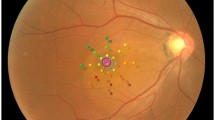Abstract
The contrast sensitivity of 21 patients was measured using TV equipment (Wavetek 143 function generator and Sony PVM90CE video monitor) and the Vistech test 6–15 years after the acute stage of central serous retinopathy. In the majority of cases contrast sensitivity was lower in the affected eye. The difference between the affected and the fellow eye was statistically significant at 1 and 6 cycles/degree (c/d) but not at 19 c/d. In 13/21 cases (62%) the results of the Vistech test were consistent with those of the TV test. Contrast sensitivity did not correlate with the duration of the disease or with the ultimate clinical picture of the macula. At 6 c/d there was a statistically significant correlation between visual acuity and contrast sensitivity. If the visual acuity was less than 1.0, contrast sensitivity was decreased, but decreased contrast sensitivity was also observed in four eyes with normal visual acuity, indicating that the level of visual deficit may not be established by measurement of visual acuity alone.
Similar content being viewed by others
References
Dickhoff K von, Hoffren M, Laatikainen L (1989) Les modifications de l'épithélium pigmentaire rétinien en rapport avec la rétinopathie séreuse centrale. J Fr Ophthalmol 12:877–881
Gass JD (1967) Pathogenesis of disciform detachment of the neuroepithelium. II. Idiopathic central serous choroidopathy. Am J Ophthalmol 63:587–615
Ginsburg AP, Cannon MW (1983) Comparison of three methods for rapid determination of threshold contrast sensitivity. Invest Ophthalmol Vis Sci 24:798–802
Kayazawa F, Yamamoto T, Motokazu I (1982) Temporal contrast sensitivity in central serous retinopathy. Ann Ophthalmol 14:272–275
Koskela PU (1986) Contrast sensitivity in amblyopia. I. Changes during CAM treatment. Acta Ophthalmol (Copenh) 64:344–351
Koskela PU (1986) Contrast sensitivity in amblyopia. Acta Univ Oul D 141, Ophthalmol Oto Rhino Laryngol 12:1–73
Mutlak JA, Dutton GN, Zeini M, Allan D, Wail A (1989) Central visual function in patients with resolved central serous retinopathy. A long term follow-up study. Acta Ophthalmol (Copenh) 67:532–536
Reeves BC, Wood JM, Hill AR (1991) Vistech VCTS 6500 charts - withinand between-session reliability. Optom Vision Sci 68:728–737
Rubin GS (1988) Reliability and sensitivity of clinical contrast sensitivity tests. Clin Vision Sci 2:169–177
Sjöstrand J, Frisen L (1977) Contrast sensitivity in macular disease. Acta Ophthalmol (Copenh) 55:507–514
Watzke RC, Burton TC, Leaverton PE (1974) Ruby laser photocoagulation therapy of central serous retinopathy. Trans Am Acad Ophthalmol Otorhinolaryngol 78:205–211
Author information
Authors and Affiliations
Rights and permissions
About this article
Cite this article
Koskela, P., Laatikainen, L. & von Dickhoff, K. Contrast sensitivity after resolution of central serous retinopathy. Graefe's Arch Clin Exp Ophthalmol 232, 473–476 (1994). https://doi.org/10.1007/BF00195356
Received:
Revised:
Accepted:
Issue Date:
DOI: https://doi.org/10.1007/BF00195356




